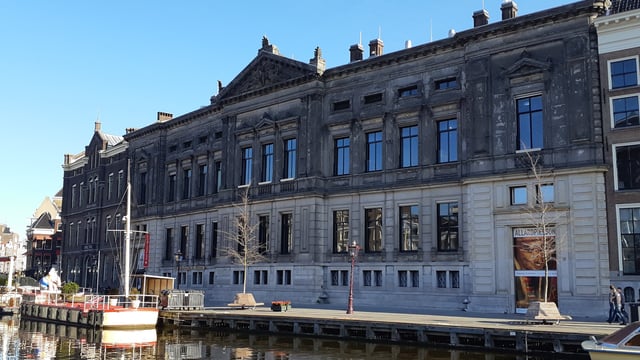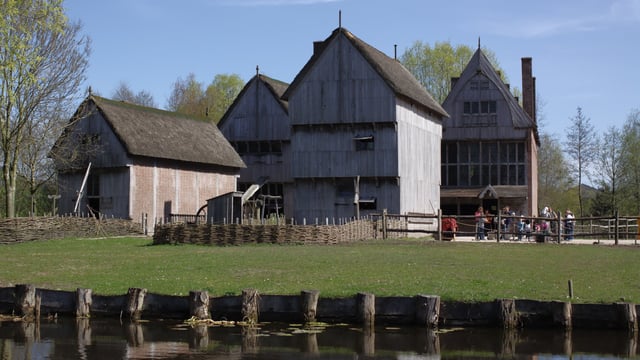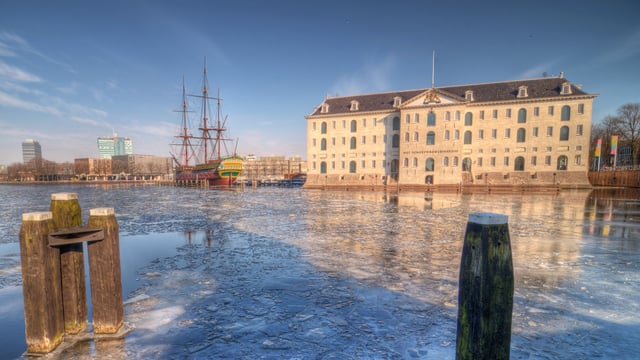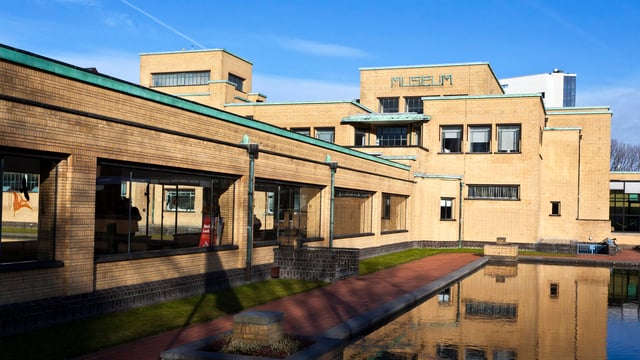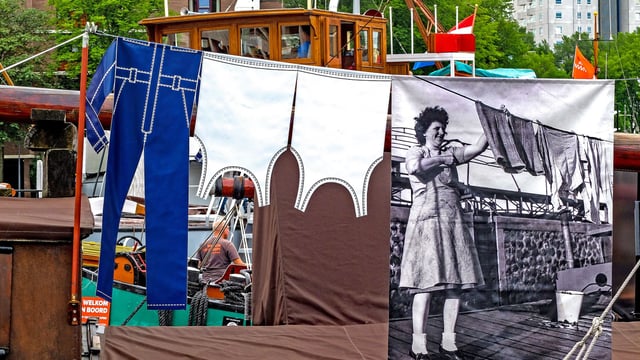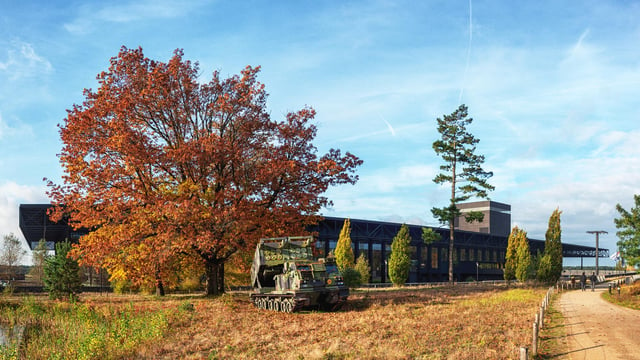Western Netherlands
Art, History & Archaeology Sites & Museums
Including Flevoland, North Holland, South Holland and Utrecht
This page, part of our Netherlands Travel Guide, provides details of the art, archaeology and history sites, museums and related attractions to visit in Western Netherlands (Flevoland, North Holland, South Holland and Utrecht). Readers wishing to visit these places will find visitor information, links to official websites as well as other helpful resources. The guide is produced and maintained by Thomas Dowson, an archaeologist and the founder of Archaeology Travel. Read more about the website, its authors and our work.
New to the Archaeology Travel website? Those who have an account (free of charge) can create personal travel lists and itineraries. To benefit fully from the various travel planning features, see the User’s Guide.
Archaeology & History Sites in Western Netherlands
Anne Frank House
The Anne Frank House offers insight into one of the more harrowing chapters of modern history. This is where the Frank family and four others hid from persecution during the Nazi occupation of the Netherlands. After they were discovered, they were sent to extermination camps, where Anne was killed. Her diary was posthumously published in 1947, with the House opening in 1960. Although queues to see the space where the young author scripted her famous journal tend to be long, it is an altogether unique experience.

Atlantic Wall Centre - Huisduinen
The striking Neoclassical building constructed in 1942 was the administrative centre and German Naval Officers’ quarters during the German occupation of the Netherlands. Until 1992 the controversial building was used by both the Artillery of the Royal Army and the Royal Navy. Following a fire in 2009 it became a centre for learning about Den Helder and the Atlantic Wall. Interactive displays, original artefacts and eyewitness accounts tell the story of the Wadden Area during the war.

Canals of Amsterdam
Any visit to Amsterdam must include experiencing this remarkable system of 17th century canals. Criss-crossing throughout the city, including through its medieval heart, the canal system has had UNESCO World Heritage status since 2011. Constructed in part for purposes of infrastructure and partially for city defence, the grachtengordel (canal-belt) is an integral feature of Amsterdam. While the canals can be observed from many of the city’s streets and bridges, you can also take a boat tour for a more immersive experience on this world-famous waterway.

Castellum Hoge Woerd
The Roman Fort in the present-day town of De Meern was a relatively small fort along the Lower Germanic Limes. The site was excavated in 1940, and besides the fort evidence of a small civilian settlement was also uncovered. The outer walls and towers of the fort have been reconstructed, and museum built within the castellum. One of the highlights of the Hoge Woerd Museum is a 25 m long river barge from the 2nd century AD, recovered by archaeologists in 1997.

Duivenvoorde Castle
Located in Voorschoten, Duivenvoorde Castle has origins stretching back to the 13th century. Substantial 17th-century alteration resulted in the castle obtaining its present appearance, a luxury home surrounded by attractive gardens. A French Baroque garden was added in the 18th century, largely replaced in the 19th with an English country garden. Over eight centuries, the castle was never sold, meaning that it passed down through familial succession from its first recorded owner, Philips van Wassenaer, something that is quite unusual.

Fectio Roman Fort
On the outskirts of Utrecht, and within walking distance of the 19th century Dutch Fort Vechten is the Roman castellum Fectio. The fort was built in either 4 or 5 AD, and later, under Emperor Claudius it became part of the Limes Germanicus. The outline of the fort and its principia have been reconstructed, but archaeological excavations also produced evidence for a port, a necropolis, as well as a civilian settlement. Embedded in the reconstructions are artefacts and tactile information panels.

Fort Kijkduin
Fort Kijkduin is a Napoleonic fort that is home to an aquarium and military museum. Napoleon visited Huisduinen in 1811, recognising the strategic importance of the location he had the fort built. Museum displays show the history of the fort, from the environment and the construction of the site, to the armoury that was used here, as well as what life was like for the French soldiers based here. The aquarium has a 15 m long underwater tunnel and allows visitors to learn a great deal about sea life in the North Sea.

Gevangenpoort - Prison Gate
In 1280 the gate to the outer courtyard served as the main entrance to the castle of the Counts of Holland. The gate to the Court became a prison in 1428, and it was here that defaulters were incarcerated and suspected criminals awaited their trials. In the 16th century, the gate was expanded to include jail cells and the courthouse. Hugo Grotius, one of the earliest advocates of international law, was a judge-advocate for the Court of Holland at the Prison Gate. The history of how the Hague comes to be a city of peace and justice starts here at the Prison Gate.

Huis Doorn
After Germany’s defeat in the First World War, Kaiser Wilhelm II was exiled to the Netherlands, a country that had remained neutral in the conflict. There he took up residence at Huis Doorn, a largely 18th-century house that he furnished with objects from his German palaces. He remained here till his death in 1941, with the house still containing many of his possessions – Wilhelm himself is buried on the premises. Displays explore the Kaiser and the Dutch perspective on the war. The house is surrounded by attractive English landscape-style grounds.

Kasteel de Haar
This is largest and perhaps most impressive castle in the Netherlands, one that cultivates a strong fairy tale aesthetic. De Haar Castle in its current form was built in 1892, the work of Dutch architect P.J.H. Cuypers, who designed it in a striking Neo-Gothic style. The castle had several predecessors, however, the oldest of which was a structure dating back to the 13th century. Outside the castle itself are a series of gardens and an area of parkland. The castle remains in the hands of the Van Zuylen family although is open to visitors.

Museums & Art Galleries in Western Netherlands
Allard Pierson Museum
Focusing on the great civilisations of the ancient world, the Allard Pierson is the archaeological museum of the University of Amsterdam. Among its collections is much material from ancient Egypt, the Near East, and the Mediterranean, including a noted selection of classical Greek pottery and Roman sarcophagi. Also at the museum are a selection of rare books, cartographic material, and one of Europe’s largest Jewish collections.
The museum takes its name from a 19th-century clergyman who served as the university’s first professor of classical archaeology.

Archaeological Museum Haarlem
The Archaeological Museum Haarlem occupies the cellar of the Vleeshal, a 17th-century building on the Grote Markt where the city’s residents once bought their fresh meat. The museum explores the archaeology of Haarlem and of the Kennemerland region more broadly, covering the area’s prehistoric inhabitants through to the urban developments of the Middle Ages. Temporary exhibits supplement the main display collection. The Frans Hals Museum is located in the same building and hosts an exhibit of modern and contemporary art.

Archeon
Archeon is an open air-museum devoted to the rich heritage of the Netherlands. With examples from prehistory to the late Middle Ages, you will see 43 reconstructed buildings ‘inhabited’ by re-enactors in period dress demonstrating traditional crafts and skills through the ages. Dugout canoes and replicas of the Gokstad Viking Ship. From gladiatorial contests in the Roman arena, Viking festivals to medieval jousting, there is plenty to experience.

Het Scheepvaartmuseum - National Maritime Museum
From the late 16th century on, the Netherlands established itself as one of the world’s major maritime powers, a period sometimes referred to as the Dutch Golden Age. Visitors can learn more about this period, and the Dutch relationship with the sea more broadly, at the National Maritime Museum in Amsterdam. Occupying a structure built in 1656, the museum underwent a major refurbishment completed in 2011. As well as its internal displays, the museum hosts a replica of the Amsterdam, a Dutch East India Company vessel that sank in 1749.

Kaap Sil Museum
The Netherlands has a long heritage as a maritime nation, and during the Dutch Golden Age of the 16th and 17th centuries the coastal settlement at Texel was an important hub for shipping. This heritage is now showcased at the Kaap Sil Museum, which preserves historic structures such as fishermen’s cottages, a grain mill, a smithy and a bakery. Although originally an open-air museum, these structures are now protected from the elements by an overarching roof. The indoor museum displays feature many artefacts recovered from shipwrecks off the Dutch coast.

Kunstmuseum den Haag
Originally established in 1866, the Kunstmuseum den Haag (or Art Museum of the Hague) now occupies a purpose-built art deco structure designed by the architect H.P. Berlage during the 1930s, one with sumptuous high-quality interiors. The museum is now home to over 160,000 works of art, ranging from collections of Delftware and Persian ceramics through to paintings by ‘modern masters’ like Monet, Picasso, and Kandinsky. The museum also boasts one of the world’s largest collections of works by the abstract painter Piet Mondrian.

Maritime Museum
With an array of interactive exhibits, the Maritime Museum at Rotterdam is not your typical museum. Visitors can learn hands on about the history of seafaring and go aboard some of the real working ships docked in the adjacent harbour. The museum also houses an array of impressive artefacts, such as the oldest model ship in Europe, dating back to the 15th century, and one of only three surviving original world maps drawn by the famed cartographer Gerard Mercator. The museum also hosts a library for those undertaking research into maritime history.

Mauritshuis Museum
Located in the centre of the Hague, the Mauritshuis is an art gallery occupying a 17th-century building originally designed as the home of John Maurice of Nassau. Maurice was a powerful man, serving as governor of Dutch Brazil, and the red-brick house reflected his social status, as well as the Dutch architectural fashions of the day. Today, the Mauritshuis has a substantial collection of 17th-century Dutch and Flemish paintings, including world-famous works like Vermeer’s “Girl with a Pearl Earring” and Rembrandt’s “The Anatomy Lesson of Dr Nicolaes Tulp.”

Moco Museum, Amsterdam
Overlooking Museumplein, the historic Villa Alsberg is home to the Moco Museum Amsterdam, dedicated to exhibiting modern and contemporary art and attracting new audiences to art. To fulfil this mission, two permanent exhibitions focus on the icons of modern and contemporary art. Modern Masters celebrates artists who have had a profound impact on art, culture and the world. Contemporary Masters showcases rising talent. The museum also hosts temporary exhibitions.

National Military Museum
Occupying the former Soesterberg Air Base is the National Military Museum of the Netherlands. And with over 300,000 artefacts, ranging from flint arrow heads to modern fighter jets, this is the largest military collection in the country. Exhibition include five interactive themed galleries, 19 aircraft, and an exhibition exploring what life was like for school children during WWII. On show in The Treasury are numerous old paintings and many different types of classic weapons. There are also indoor and outdoor activities for children.














